Checking back into the Match Racing Game
Published on April 14th, 2016
by Peter Isler
My friend Scotty Dickson had just called me up asking if I’d fill in a last minute opening in his crew for the Ficker Cup on April 1-3, which is the Congressional Cup qualifier hosted by Long Beach Yacht Club.
My calendar was open and before I responded with the usual “no”, I thought about all the times my friends had helped me out at the last minute in similar situations. So upon consideration, of course I could spare a few days for Scotty – he’s a good friend and I was a little intrigued to check back into the match racing game.
My history doing match races at Long Beach Yacht Club goes back nearly as far as my match racing career. I sailed as Dave Perry’s tactician to win two Congressional Cups in the early 80’s. Then, after winning my first America’s Cup with Dennis Conner and the Stars & Stripes team, I set out in earnest to focus on the fledgling match racing tour.
I had a great team – and good success – winning six tour events and enjoying the top spot amongst all Americans in the match racing rankings for a number of years. In fact, along with Peter Gilmour and Eddie Warden Owen, we founded the Professional Match Race Sailors Association which created the Match Race ranking system that is still in use today. After obtaining sponsorship running the rankings for a few years, and helping to grow the match racing tour (which was our goal), we handed the rankings over to World Sailing (then ISAF).
Suffice to say that pro match racing was a big part of my life for many years. But I left the tour in the mid 90’s – when I was in the midst of creating what became the America3 Women’s Team for the 1995 America’s Cup – and never went back.
Sure, I did plenty of match racing in my three subsequent America’s Cup campaigns (Stars & Stripes 2000, 2003 & BMW Oracle 2007), but my last match racing regatta before this year’s Ficker Cup was the 2010 Louis Vuitton Trophy in Italy sailing in the back of an IACC boat with Ben Ainslie, Iain Percy and the late Bart Simpson.
Long story short, it had been a long time.
So when I opened up the sailing instructions on the practice day of the Ficker Cup, I was in for a shock. Although the regatta format was the same as the Congressional Cup (round robin followed by semis and finals), and the Long Beach boats remain the venerable Catalina 37’s that I’ve sailed countless times, the game is very different.
Here’s some of my big “take-aways” from the 2016 Ficker Cup – which ended successfully for us – as we made it into the Finals – qualifying Scotty for an automatic invitation to the Congressional Cup which started two days later.
No push overs. At this level (the Ficker Cup was an ISAF grade 2 event), every team knows how to match race and every team knows how to get a small to medium sized keelboat around a very short (15 min) W/L course. A four boatlength lead – which in the “old days” was still a close race – is now a horizon job.
Game change at the top mark. This is the biggie. Even the international umpires were a bit confused (some things never change) at the skippers meeting as to which set of rules we were using at the regatta. It turns out the World Match Racing Tour has its own set of Right of Way Rules – which are different from the Match Racing Rules (Appendix C in the “normal” Rule Book)… and the powers that be are still fiddling with those rules.
As you can imagine – any rule change has both intended and unintended consequences…so it’s no surprise that the teams that have played by the Tour Rules have a big advantage (at some stages in the race) over good sailors trying out the big leagues for the first time. Anyways – it turned out we were using a special “Congressional Cup 2016 version” of the Tour Rules for our event. I didn’t take the time to figure out how that version differed from the Tour Rules – that would have only confused me more!
Bottom line is the top mark game is now very similar to what we saw being played in the AC World Series leading up to 2013 America’s Cup in San Francisco. The mantra for teams back then were “the boat that gets to the zone first ‘owns’ the mark” and “inside boat ‘owns’ the mark”.
Match racing features starboard roundings at the top mark so picture this: two port tackers – overlapped – reach the two boat length zone – the windward boat is laying the mark – the leeward boat is well understood. Under the new rules, the leeward boat (which is the “inside” boat in the eyes of the rules) can tack over with no fear of “tacking too close” to ‘step up’ and lay the mark and the windward boat has to keep clear – that takes some anticipation to say the least!
Open course luffing. Even the Match Racing Rules in Appendix C have deleted RRS 17… so a boat that establishes an overlap from astern has luffing rights from the get go (after a couple of beats to satisfy the transition). Now on the match racing circuit you really have to be careful when applying a lee bow tack (especially from starboard to port) because competitors have learned to simply duck astern of the tacking boat and immediately start luffing them – forcing the tacking boat to keep clear and do a second speed robbing maneuver in short order.
Attacking downwind. If you can keep the game close – the downwind legs are where the trailing boat has a good chance to catch up and make a pass. That’s the way its always been, but today’s match racers have refined their moves to such a point that both the defender (leader) and attacker (trailer) have to really be on their toes to avoid getting spat out of the back on the run.
Red flag penalty. In the normal Match Racing Rules, a Red Flag from the Umpire boat meant they thought your rule violation was such that you gained an advantage in the race so you had to do an immediate penalty turn (not delay it like you can for a normal penalty). But under the Tour rules, a boat that’s been red flagged has two options – the immediate penalty turn or simply turning down behind the other boat and crossing behind them. We didn’t get to see this happen in real life during the Ficker Cup, but apparently there are all sorts of games that can be played by both boats when this sort of a penalty is issued.
The Dial Up. When I first started match racing, a dial up would have resulted in a protest against starboard tack boat that would have likely held up in the “room”. But for years – as the sailors and umps got more comfortable with close quarter combat – the dial up has been ubiquitous as the first move in the pre-start battle. Today’s match racers have taken that whole game to a new level and they are much better at “no speed” boat control.
Jib Down in a luff – Kite up in the pre start. When luffing head to wind on the open course, you lose less speed if you have less sail area flapping up there. And when you go to accelerate, the boat that is “faster” usually wins. Match racers knew that a decade ago, but you rarely saw jibs actually being lowered in a big luffing match. But today’s teams are super quick on the jammer to lower the jib any time its flapping is detrimental. It’s part of their normal repertoire – as is hoisting a kite during the pre-start when you get too far upwind battling your opponent.
Million dollar prizes. Enough said!
Those are just a few of the big differences that I noticed during my few days back playing the game. Luckily, a lot of things have not changed, like the importance of picking the correct side of the course and trying to make less maneuvers than your opponent. It was all good fun and I enjoyed the new generation of match race sailors. I couldn’t make the Congressional Cup – but was super proud to see Scotty and team make it to the final four!


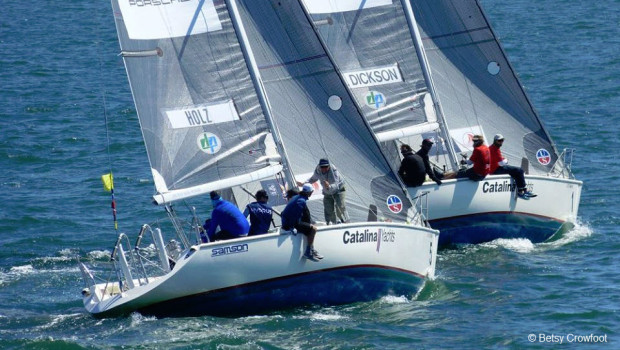


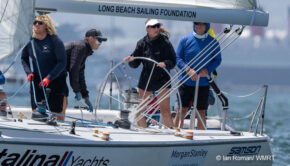
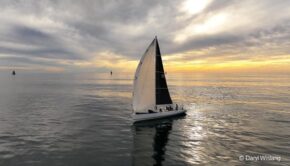
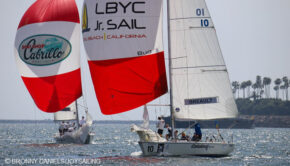
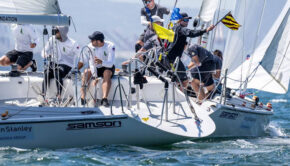
 We’ll keep your information safe.
We’ll keep your information safe.